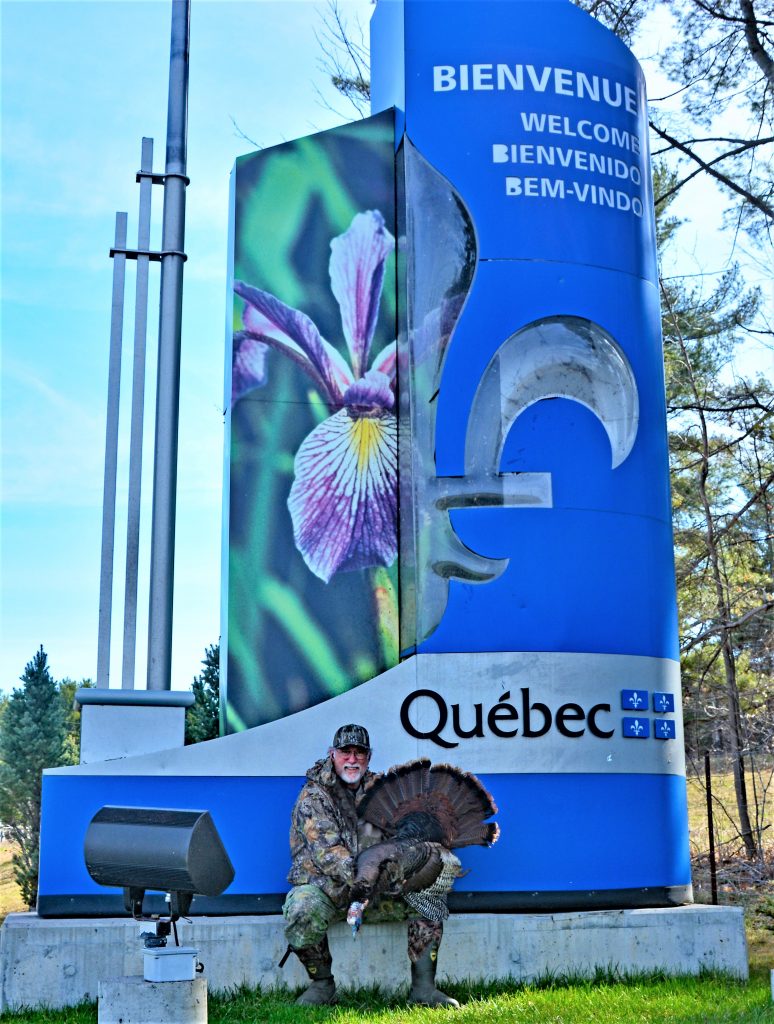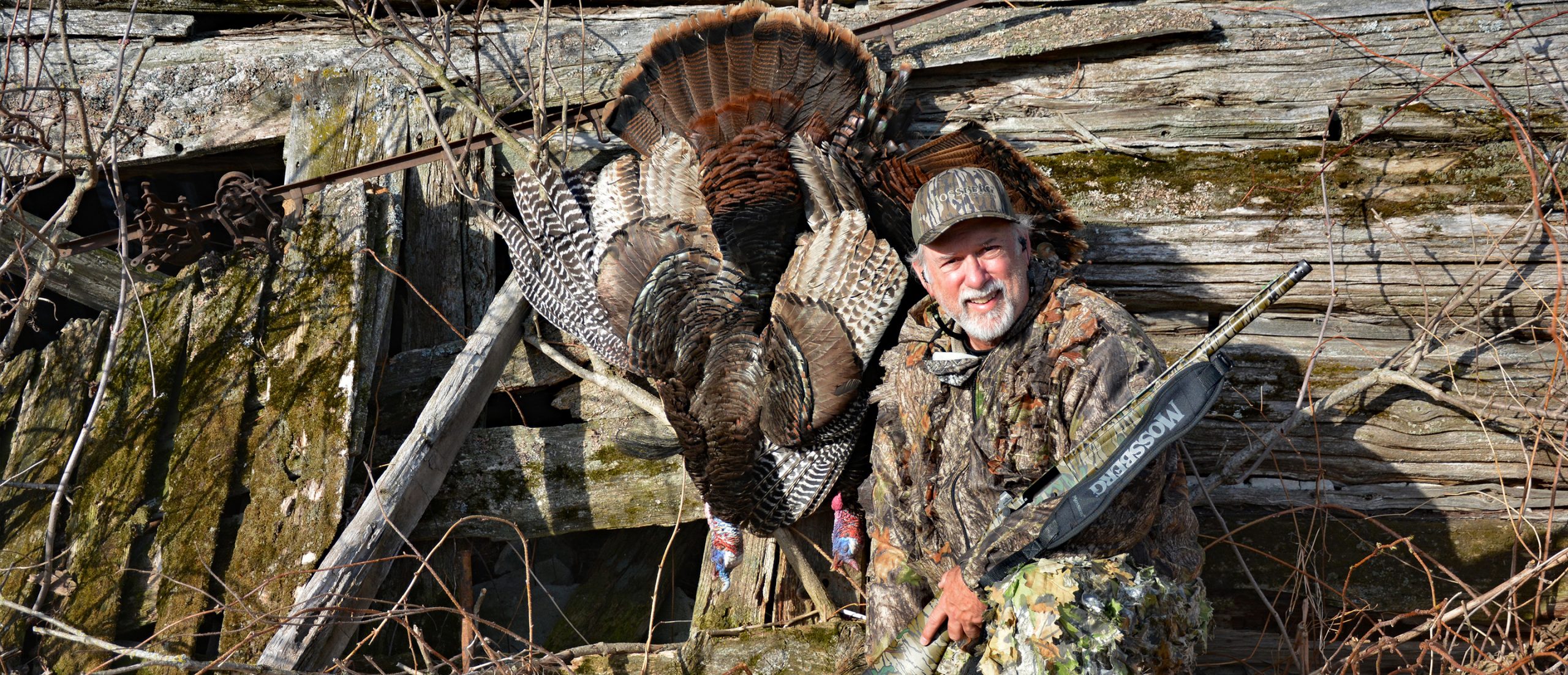Oh Canada!
Tagging toms on the fertile farms of southern Quebec and Ontario, eh.
Daylight was fading fast as Alex “Sasha” Hynes pulled alongside a spacious farm field and raised his binoculars to inspect three dark shapes moving toward the wood line.
“That’s a nice gobbler,” Hynes said, handing me the glasses.
Confounding things, though, was a large sow black bear with three cubs. The bears were feeding intently just a few hundred yards from where the turkeys entered the woods.
“I think this tom gives us the best chance in the morning,” Hynes said.
We were looking at the final day of a three-day hunt. Despite seeing dozens of gobblers across our morning hunts in Quebec and afternoon hunts in Ontario, none of my tags had been punched yet.
“Let’s just hope mama bear leaves us alone,” Hynes said as we drove away.
This early May 2022 hunt with Hynes, Marc Lapierre and Matt Neville of gohuntbirds.com staged out of Chapeau, Quebec, just across the Ottawa River from Pembroke, Ontario. We were hunting with Mossberg’s Linda Powell and Canadian outdoor communicator Ian McCleary, shooting Mossberg’s new 940 Pro Turkey semiautomatic shotgun.
The Quebec hunting mostly took place on L’Isle-aux-Allumettes, a several-mile-wide island spanning the river. Quebec allows turkey hunting until noon; Ontario permits hunting until 7 p.m. Each province has a two-bird limit, and Quebec lets hunters bag both gobblers in one day. Taking three birds in one day – two in Quebec and one in Ontario – is something Lapierre calls the “hat trick,” so named after the feat of scoring three goals in a hockey game.
Wild turkeys are thriving in this part of Canada, a region dominated by huge expanses of agricultural land punctuated by small woodlots. Extirpated in the early 1900s, turkeys were reintroduced in Ontario beginning in 1984 with some 4,400 trap-and-transfer birds coming from multiple locations in the United States. Some turkeys also migrated naturally to Ontario and Quebec from New York and Vermont.
Playing Hard to Get
Powell and I quickly learned that Canadian turkeys are just as obstinate as their American cousins.
The first night in camp, we roosted four mature gobblers and a couple hens, watching as they took a running start before flying into a narrow strip of pines close to a main roadway. We set three decoys in the morning dark, then sat along a fencerow. Anticipation built as the turkeys awoke and gobbled intently for nearly 30 minutes before pitching down close to where they had launched to their roosts.
“This is going to be easy,” I foolishly thought, cursing our efforts. One gobbler was boss, the main strutter. A dominant hen had him firmly by the snood. Spotting our decoys, she said, “I don’t think so,” proceeding to lead her guy and his wingmen away.
We split up the next morning. Powell hunted with Neville while I hunted with Hynes, whose family owns a sprawling farm on the island. Hynes speaks several languages, courtesy of a Canadian father and Ukrainian-born mother.
Hynes and I saw at least eight gobblers the second afternoon cruising a freshly plowed field. The cropland was broken up by three substantial woodlots. We set up precisely where Hynes had seen numerous turkeys the day before. The turkeys didn’t get the “stay put” memo and moved, now appearing at the adjacent patch of woods. They refused to cross the field for us, and we were too exposed to make a move. Field turkeys – what can you do?
He Shoots. He Scores!
That final Quebec morning was cold at 29 degrees. As we silently crossed the field to set up, I hoped the sow and cubs had moved off or were sleeping well into the woods. The only adrenaline I wanted to experience was anticipating a shot at a gobbler, not a protective sow huffing down my neck as I sat in the dark.
Gobblers and wolves sounded off early in the distance. The sun had yet to crest the distant, eastern tree line when a single hen approached our decoys from the right. Hynes, sitting just behind me, hushed an alert to look left. The two hens had emerged and were heading into the field, completely ignoring the decoys and our gentle calls. I shifted my body position, anticipating the gobbler’s arrival while worrying this might be a “second verse, same as the first” morning.
He soon popped into sight and began following the hens. Unlike the previous gobblers, though, this boy hedged his bets and began tracking at a 45-degree angle between the two real girls and our decoys.
Every breath created a vapor cloud, accentuating the intensity I always feel when a shot is imminent. I centered the Holosun optic’s green aiming circle on the turkey’s head and squeezed the Mossberg’s trigger. A 2¼ -ounce load of No. 7½ Apex TSS pellets at 38 yards flopped him in the frosty field.
While heading toward a scenic overlook on the river to take some nice early morning photos, we spotted several turkeys a few hundred yards away. Each had a red head. We snuck to a clearing just below the turkey congregation. All we had to do was coax one down a small hillside. Multiple gobbles erupted after just one call. A hard cut and a shake of a gobbler call prompted a frantic jailbreak with birds racing down the hill. The first two kamikazes were jakes, but the third was a mature bird. Let’s just say that tungsten at 18 yards is utterly lethal.
A Lucky Break
Not tagging an Ontario turkey was disappointing, but I still looked forward to a walleye and smallmouth bass fishing trip on the storied St. Lawrence River. Lapierre had arranged the trip with David Roy, a buddy who runs St. Lawrence Outfitters (www.stlawrenceoutfitters.com).
While fishing, I learned that Josh Brugmans, one of Roy’s waterfowl guiding partners, offered turkey hunts. I decided to extend the trip one more morning.
Daybreak saw a repeat of the first morning’s experience in Quebec, with multiple gobblers mesmerized by a single hen. After nearly five hours of frustration, we decided to leave and look for birds that might give us a chance. We soon spotted two longbeards seemingly feeding alone at the edge of a patch of swampy woods. We circled to the opposite side of the narrow swath of woods, crossed a water-filled ditch and quietly snuck in.
Thick saplings and young trees made for a tough set up. Thankfully, the Mossberg 940 had the 18½-inch barrel, making maneuvering much easier in the dense vegetation.
Brugmans skillfully issued a couple yelps. An aggressive cutt from his mouth call triggered an explosion of gobbles, clearly from more than two birds. I quickly found a dry spot to sit, snapped down some nearby vegetation and raised the Mossberg. Brugmans called again. Seconds later, all we saw were red heads scrambling toward us, a mix of immature males and a couple of longbeards. The 19-yard shot provided an adrenaline-packed, fast finish to a fortuitous Ontario gobbler quest.
Travel Notes

Ontario’s licensing requirements are a little more onerous than Quebec’s. You first need to get an Outdoor Card (available online) and then upload proof of a valid hunting license and hunter education certificate before you are allowed to buy the required small game license ($121 CAD) and a la carte turkey tags (up to two at $30.33 CAD each).
No hunter education certificate is required in Quebec for nonresidents. Buy online or simply fill out a form at a local grocery store and pay the $185 CAD fee, which includes two tags. Checking your birds is required in both provinces. Neither Quebec nor Ontario had yet authorized No. 9 shot for turkey hunting.
